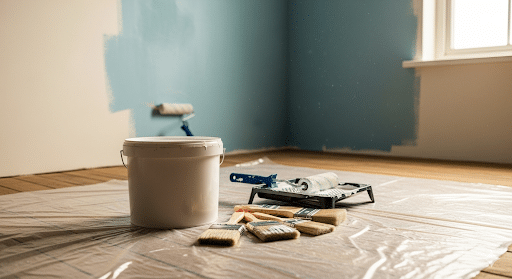Many homeowners notice strong chemical smells after painting and wonder about safety.
The odor lingers for days, causing headaches and concerns about air quality. Families with children or pets feel especially worried about these fumes.
Volatile Organic Compounds are chemicals that evaporate from wet paint into the air. They create that familiar paint smell and can affect indoor air quality and health.
This blog explains VOC levels, health impacts, and how to choose safer paints.
What is VOC in Paint, and Why are they Used?
VOCs, or Volatile Organic Compounds, are carbon-based chemicals that easily turn into gases at room temperature.
In paint, they are found in solvents, thinners, and other ingredients that make the product easier to use.
VOCs help paint spread smoothly, dry at the right speed, and form a strong, lasting finish. This is why they have been used for so many years in traditional paint formulas.
However, oil-based paints typically contain higher levels of VOCs, whereas modern water-based paints contain significantly less.
Choosing paints with lower VOCs can make painting safer and keep indoor air cleaner.
VOC Composition
Below are the common VOC compositions found in paint and their role in how paint works:
- Aromatic hydrocarbons like toluene, xylene, and ethylbenzene.
- Alcohols such as ethanol, isopropanol, and n-butanol.
- Ketones like acetone, methyl ethyl ketone (MEK).
- Esters, e.g., butyl acetate, ethyl acetate.
- Glycol ethers are common in water-based paints to help flow and film formation.
- Aldehydes like formaldehyde, sometimes released as a byproduct.
Types of VOC Levels in Paint

VOC content refers to the amount of volatile organic compounds in paint, expressed in grams per liter (g/L). It indicates the amount of chemical vapor that the paint may release indoors.
The following are the common VOC levels you’ll see on paint labels:
1. Regular Paint (High VOC Levels): Regular paints, especially oil-based ones, often contain 150 g/L or more VOCs, producing strong odors and fumes that harm indoor air quality and human health.
2. Low-VOC Paint (Safer Everyday Option): Low-VOC paints contain 50 g/L or less, emit fewer gases with a lighter scent, and are commonly found in water-based formulas, while still providing good durability, coverage, and finish.
3. Zero- or No-VOC Paint (Health-Friendliest Choice): No-/Zero-VOC paints contain under 5 g/L, are not truly “zero”, especially after tinting, but remain the safest option for indoor air quality, ideal for homes with children, the elderly, or sensitive individuals.
4. VOCs After Tinting (Hidden Factor to Watch): Adding store colorants can raise VOC levels, meaning even zero-VOC bases may increase after tinting, so it’s important to always check the “VOC after tint” information.
Difference Between VOC, Low-VOC, and No-VOC Paints
Below is a table comparing VOC, Low-VOC, and No-VOC paints for easy understanding:
| Feature | VOC (Regular Paint) | Low-VOC Paint | No-/Zero-VOC Paint |
|---|---|---|---|
| Smell & Emissions | Strong odor, long-lasting fumes | Milder smell, fewer emissions | Minimal odor, lowest emissions |
| Common Use | Oil-based paints, older products | Most modern water-based paints | Eco-friendly, interior-safe options |
| Durability | Very durable, tough finish | Durable and reliable for most interiors | Good for interiors, may need more coats in some cases |
| Best For | Outdoor use, heavy-duty areas | Everyday home interiors | Bedrooms, nurseries, healthcare, or sensitive spaces |
| Key Notes | Higher health risks, poor indoor air quality | Good balance of performance and safer air | Not truly “zero,” tinting can raise VOCs |
Health Issues Caused

Below are some common health issues linked to VOC exposure from paints.
Eye, Nose, and Throat Irritation
VOCs can quickly irritate the eyes, nose, and throat, causing symptoms such as burning, itching, or a runny nose.
This discomfort often occurs soon after painting, especially in rooms with poor ventilation, and can last for hours until the air clears.
Headaches and Dizziness
Breathing in paint fumes containing VOCs may trigger headaches, dizziness, and nausea.
These symptoms usually appear during or right after painting. People who spend long periods in freshly painted spaces without ventilation are more likely to feel these uncomfortable side effects.
Respiratory Problems
VOCs can worsen asthma, allergies, or other breathing issues. They may cause coughing, wheezing, or shortness of breath.
Children, elderly individuals, and those with pre-existing respiratory conditions are particularly vulnerable to the harmful effects of VOC emissions when exposed indoors.
Fatigue and Nausea
Prolonged exposure to VOCs can lead to feelings of tiredness, weakness, or nausea. These symptoms often make it more difficult to concentrate or feel at ease.
Poor air circulation during and after painting increases the likelihood of experiencing these side effects for a longer period.
Long-Term Health Risks
Some VOCs, such as formaldehyde or benzene, are known to be hazardous when repeatedly exposed to.
Over time, they may damage the liver, kidneys, or nervous system and are linked to cancer. Consistent exposure to indoor environments without protection carries the highest long-term risks.
Safer Alternatives to High-VOC Paints
The following are some alternatives to high-VOC paints that help protect indoor air quality and promote better health.
- Low-VOC Paints: Contain 50 g/L or less, offering safer indoor air with good durability.
- Zero-/No-VOC Paints: Under 5 g/L, safest for homes with kids, the elderly, or sensitive people.
- Latex (Water-Based) Paints: Use water instead of solvents, giving off fewer VOCs and less odor.
- Natural and Plant-Based Paints: Made from clay, lime, or plant oils, eco-friendly with minimal chemicals.
- Powder Coatings: Applied as dry powder, release almost no VOCs, mainly for furniture and metals.
- Milk Paint: Non-toxic, biodegradable paint made from milk protein and natural pigments for a rustic finish.
Conclusion
Choosing the right paint means more than just picking colors; it’s also about protecting your health.
Understanding what VOCs are in paint empowers homeowners to make safer choices for their families and indoor air quality.
Low-VOC and natural alternatives offer safer solutions without sacrificing quality. Water-based latex, milk paint, and plant-based formulas provide excellent results with fewer fumes.
Which type of paint will you choose for your next project?


















